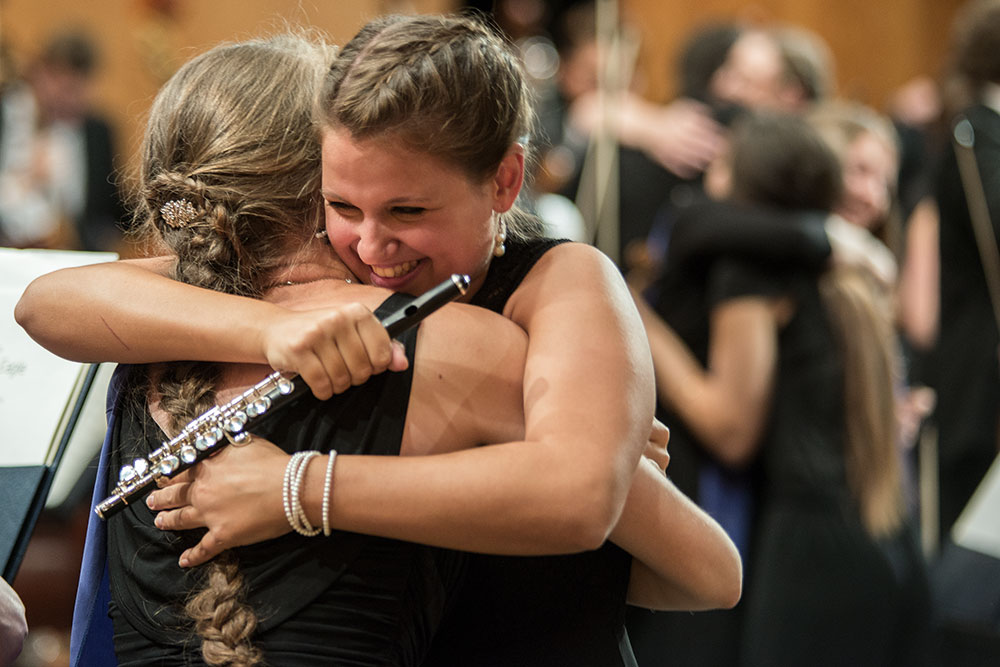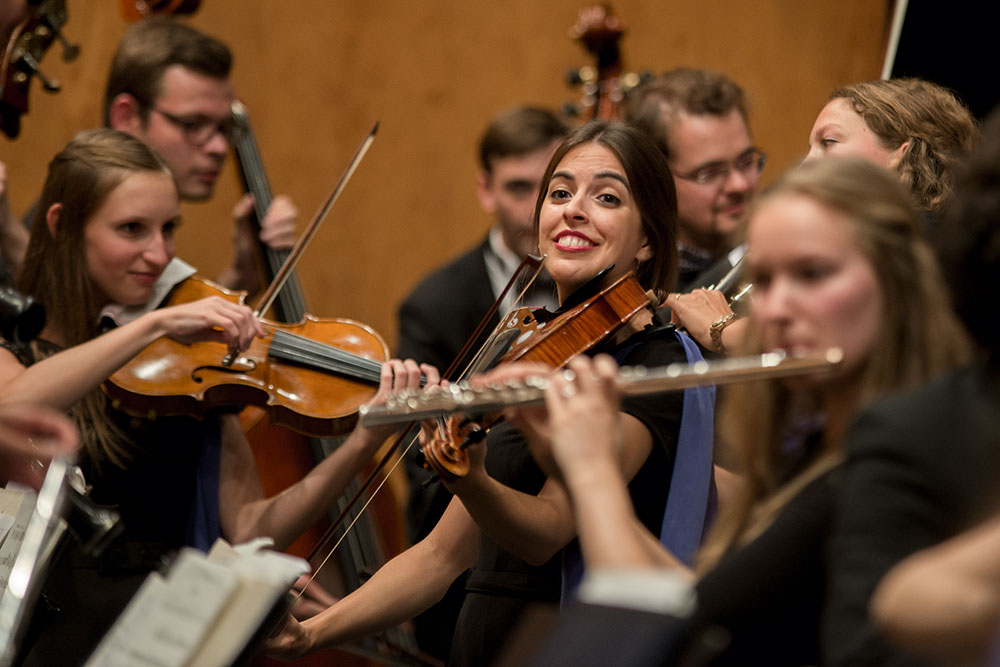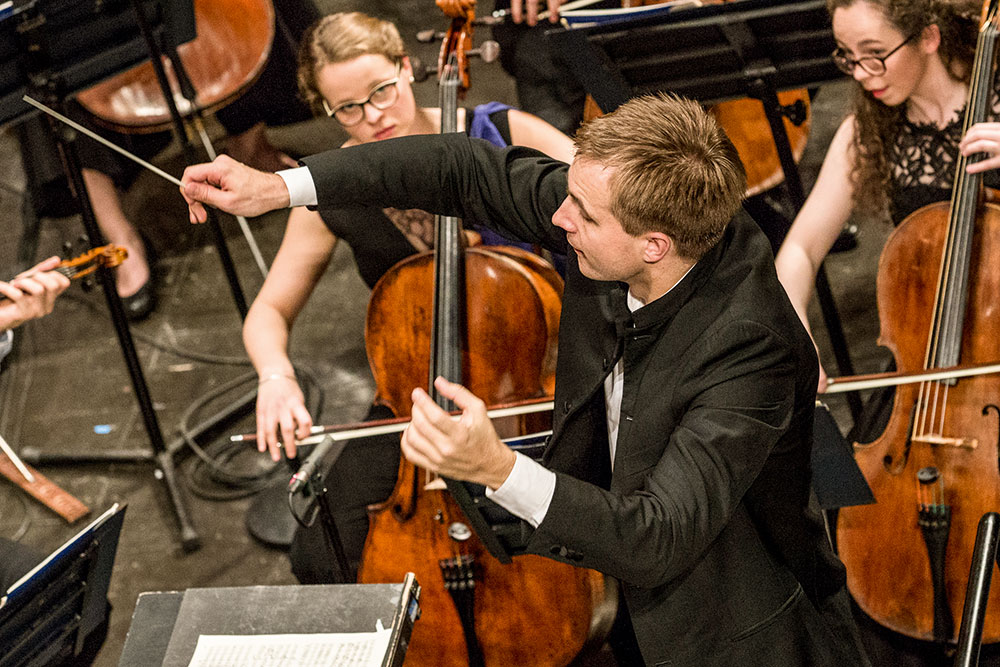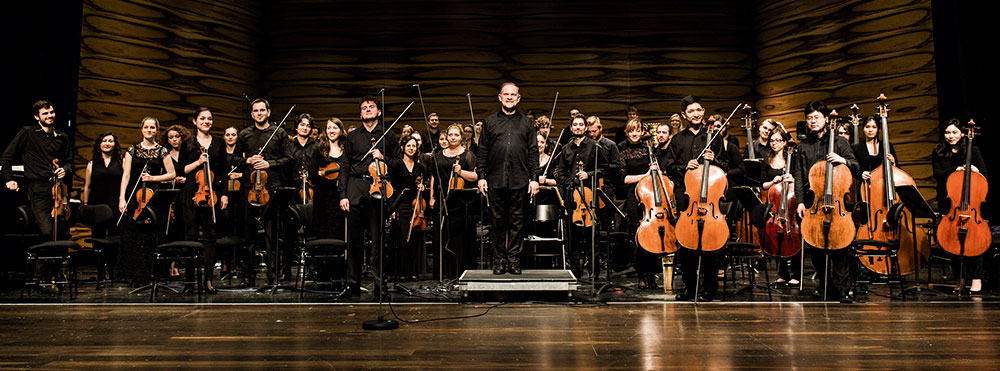“Ascent to the world stage” is how the mdw defined one of its guiding principles in its bicentennial year of 2017. Many mdw alumni realise this by becoming part of a large ensemble, performing as members of an excellent international orchestra. But how to get there? What steps are helpful—or, in fact, necessary? On this question, mdw Magazine interviewed representatives of several institutions outside the university.
This much is certain: studying is one major step among many, and experience is important. During their university studies, students gather such experience in groups like the Webern Symphonie Orchester, which plays operatic and symphonic repertoire—including annual performances at the Golden Hall of the Musikverein with well-regarded conductors such as Ricardo Muti and Franz Welser-Möst (see the interview with Helmut Zehetner, p. 20) Complementary outside offerings range from tuition-charging summer courses, youth orchestras, and festival orchestras to payed orchestra academy positions.

The Wiener Jeunesse Orchester (WJO), for example, brings together a new and select group of musicians between ages 16 and 26 from all over Austria each year. And even just its auditions represent a good opportunity to gather experience, with everyone who tries out receiving feedback. WJO General Manager Renate Böck says that alongside players’ technical level, having a good atmosphere in the orchestra is of special importance. That’s when team spirit arises, she says, making it a joy to play together. And incidentally, she continues, the following still holds true: “You only learn to play in an orchestra by playing in an orchestra”—be it in terms of listening, of one’s ability to adapt, of communication skills, or of assuredness. “Sometimes an orchestra sets out to tackle a difficult piece, and nothing seems to work—but suddenly, after two days of rehearsal, things start coming together.” Getting to know such processes strengthens musicians in an important way, says Böck. “We also offer workshops. In these, we discuss taboo topics as a group—topics like anxiety about performing and about the future. That’s very liberating and does the entire group good, with people feeling how they’re not alone.” What’s more, the Federation of National Youth Orchestras (EFNYO) makes it possible for WJO members to also play in other European youth orchestras—an experience that broadens their horizons.

Every year, music students from all EU member states are listened to and selected by the European Union Youth Orchestra (EUYO)—and this year once again sees mdw students participating in this process with high hopes and full of anticipation. This orchestra’s tours combine classical concerts at top venues with outreach projects such as flash mobs and performances together with regional (folk) musicians. These experiences are very important, says the EUYO’s CEO Marshall Marcus, and he explains why he believes this is so: playing in an orchestra should encourage intercultural communication and nurture the ability to work together with different people—skills that are essential for professional musicians, but also of significance to society at large. “One should not underestimate the importance of learning to work well with other people.”
An important partner for the EUYO is Campus Grafenegg. Work to nurture young talents takes place there in collaboration with multiple partners, from the Lower Austrian Youth Symphony Orchestra to the Campus’s own Grafenegg Academy Orchestra, a programme that’s advertised worldwide; it thus offers one step after another, explains Magdalena Klamminger, who heads artistic activities at the Campus.

It’s increasingly the case that professional orchestras are likewise devoting themselves to supporting young players: last summer, the Vienna Philharmonic announced the establishment of an orchestra academy, and the Tonkünstler Orchestra is working on expanding the number of positions and offerings for its own academy players.
The mdw, as well, is introducing important new measures to this effect in its curricula and extracurricular offerings as well as reacting to the changing demands on professional musicians. The mdw’s Career Center, the mdw club and the Centre for Further Education are organising events including workshops on self-marketing and career planning. And an important project unto itself is the Webern Kammerphilharmonie. The idea of building a bridge to the working world with the University’s own professionally organised chamber orchestra was born during Rector Ulrike Sych’s term as vice rector, and since 2015, outstanding students and alumni have been playing together at internal events and external engagements—eliciting delight inside and outside the University: “I think it’s great that most of the players are already experienced,” says long-time member Mihajlo Radivojevic, now solo bassoonist in the Croatian Radiotelevision Symphony Orchestra in Zagreb. Orchestra member Christina Hecher, who’s currently also in the academy of the Tönkünstler Orchestra, thinks “it’s good that things run very much like they do in professional orchestras—the number of rehearsals, having a head conductor, and working with lots of guest conductors. And the musicians there play at a very high level.” Radivojevic adds: “This project shows how the University works to support its students.” Paul Hofmann’s organisational team has frequent cause for an ironic laugh: “A challenge in working for the Kammerphilharmonie is that our members are constantly getting ‘poached’—though this does make us happy, of course! It speaks to the quality of our musicians.”

Numerous examples underline the importance of these various initiatives, but stringent analysis of musicians’ careers would be an important step, say both Böck (who already conducted a study of her own on ex-WJO members) and Marcus (“Research should be done!”), in order to be able to better understand and accompany modern career paths of orchestral musicians.

